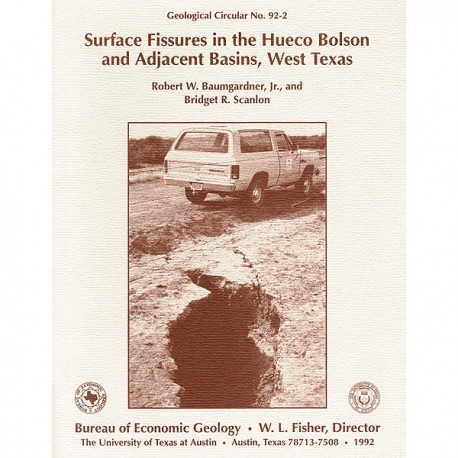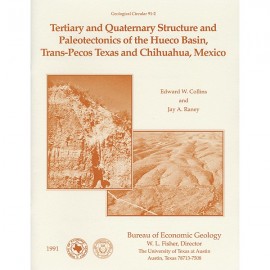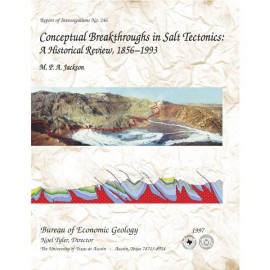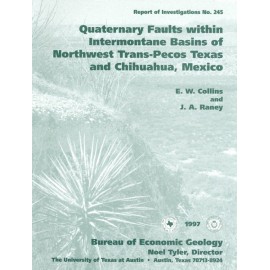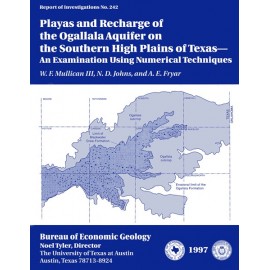Geological Circulars
-
Books & Reports
- Reports of Investigations
- Guidebooks
- Udden Series
- Geological Circulars
- Down To Earth
- Atlases of Major Oil and Gas Reservoirs
- Texas Memorial Museum Publications
- Environmental Geologic Atlas of the Texas Coastal Zone
- Mineral Resource Circulars
- Other Reports
- Seminars and Workshops
- Handbooks
- Submerged Lands of Texas
- Symposia
- Annual Reports
- Open File Reports
-
Maps & Cross Sections
- Thematic Maps
- Miscellaneous Maps, Charts & Sections
- Geologic Atlas of Texas
- STATEMAP Project Maps
- Geologic Quadrangle Maps
- Cross Sections
- Highway Geology Map
- Energy and Mineral Resource Maps
- Shoreline Change and Other Posters
- Wilcox Group, East Texas, Geological / Hydrological Folios
- Bouguer Gravity Atlas of Texas
- River Basin Regional Studies
- Featured Maps
- Posters
- Teachers & the Public
-
Geological Society Publications
- Gulf Coast Association of Geological Societies
- Alabama Geological Society
- Austin Geological Society
- Corpus Christi Geological Society
- Houston Geological Society
- Lafayette Geological Society
- Mississippi Geological Society
- New Orleans Geological Society
- South Texas Geological Society
- GCS SEPM Publications
- Historic BEG & UT Series
Surface Fissures in the Hueco Bolson and Adjacent Basins, West Texas
GC9202
A free, digital version of this publication can be found on: Texas ScholarWorks
GC9202. Surface Fissures in the Hueco Bolson and Adjacent Basins, West Texas, by R. W. Baumgardner, Jr., and B. R. Scanlon. 40 p., 19 figs., 2 tables, 1992. ISSN: 0082-3309. Print.
To purchase this publication as a PDF download, please order GC9202D.
ABSTRACT
Surface fissures have been observed in many desert basins in the western United States. These surface-collapse features are usually discovered after a normally dry surface has been covered with water, either by runoff from intense rainfall, by flooding, or by irrigation. Their sudden appearance attracts the attention of local residents, especially when the fissures render unpaved roads impassable. Collapse features begin as near-surface tension fractures that are enlarged by erosion and piping. Uneroded tension fractures are typically 0.1 to 7.6 cm wide and are filled with fine-grained sediment. Surface-collapse features may coalesce to form fissures, some up to 15 km long. Maximum reported depth of fissures or fractures is 25 m. Most tension fractures have formed where ground water has been pumped and water levels have dropped significantly (30 to 140 m). However, some fractures exist where no substantial pumping has occurred and no corresponding drop in water tables has been recorded. These features may have formed as a result of the lowering of ground water over geologic time. Tensional stress leading to fracture formation may result from differential compaction of unconsolidated sediments over bedrock irregularities or abrupt sedimentary facies boundaries or from desiccation. Seismic activity, although not a prerequisite for formation of collapse features, in some instances may trigger the development of tension fractures. Near-surface tension fractures may remain undetected until they are enlarged by piping and the surface above them collapses. Polygonal and branching patterns of fissures suggest desiccation as a cause of fracture genesis, but this origin remains unproven.
Fissures at the Hueco Bolson study area in western Texas are located on a flat-lying alluvial slope on Cenozoic sediments that fill a small basin in Cretaceous bedrock. The basin is separated from the main part of the Hueco Bolson by the Campo Grande fault. All three fissures at the Hueco Bolson study area are in topographic lows, indicating that overland flow is important to their development. The conditions necessary for piping to occur probably exist in the study area only in topographic lows during and after heavy rains.
Detailed study of fractures reveals that walls of fractures that underlie fissures match across each fracture's midline, evidence of simple tensional separation. These fractures are filled with silty, clayey sediment that contains vertical, clayey laminae, suggesting multiple periods of filling or fracturing or both. Fracture fill conducts water more readily than surrounding sediments, as seen at fissure 1. Low chloride concentrations down to 4.6 m below the surface near this fissure indicate that relatively high moisture fluxes occur there, compared with moisture fluxes in sediments in ephemeral stream channels and on low-lying interfluves. Unlike in fissured areas elsewhere in the desert Southwest, there has been no significant ground-water pumping in the vicinity of the study area. However, four factors have led to lower ground-water levels in the study area over geologic time: incision of the Rio Grande, change to a warmer, drier climate, fault movement on the Campo Grande fault, and preferential drainage of relatively permeable basin fill beneath the study area. These fissures and those that form where ground water has not been pumped are natural geomorphic features of the desert Southwest.
Keywords: fissures, ground-water withdrawal, Hueco Bolson, hydrology, Quaternary stratigraphy, soil piping, subsidence, tension fractures, Trans-Pecos Texas
Citation
Baumgardner, R. W., Jr., and Scanlon, B. R., 1992, Surface fissures in the Hueco Bolson and adjacent basins, West Texas: The University of Texas at Austin, Bureau of Economic Geology, Geological Circular 92-2, 40 p.
